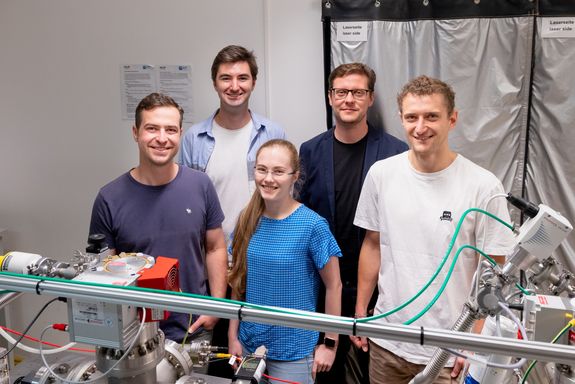If you want to photograph something very fast, you need a camera with a very short exposure time. The same principle applies everywhere in physics: for example, extremely short laser pulses are used to visualise the processes that take place within atoms.
However, it is not only laser pulses that provide answers to unsolved questions in physics, but also ion pulses: a new method has now been used to generate extremely short, powerful pulses of charged particles, which can then be shot at a surface in a precisely controlled manner in the future. This will make it possible to analyse very fast processes that take place on this surface. For example, chemical processes can then be analysed while they are still in progress.
Usually, you can only see what remains
“Ion beams have been used for a long time - to analyse materials, but also to clean or modify material surfaces,” says Prof. Richard Wilhelm from the Institute of Applied Physics at TU Wien. “Normally, however, you only ever get to see the end product: You shoot ions at a surface and then look at how the material has been changed as a result. The great difficulty so far has been to generate such short ion pulses that they can be used to follow the temporal course of the impact.”
The ion pulses generated in the laboratory at TU Wien last less than 500 picoseconds. A picosecond is one millionth of a millionth of a second - a time span that is almost unimaginably short by human standards. Even light travels just 15 centimetres in 500 picoseconds. This is still millions of times longer than the shortest laser pulses in the world, which run on a time scale of attoseconds. However, this time scale enters the optimum range for analysing surfaces.
Lasers generate electrons, electrons generate ions
In order to generate such extremely short ion pulses with high intensity, a multi-stage process had to be developed: First, a laser pulse is shot at a cathode, which then emits electrons. These electrons are accelerated and hit a stainless steel target. “Certain atoms always accumulate on the stainless steel surface, for example hydrogen and oxygen,” says Richard Wilhelm. “When the electrons hit this layer of attached atoms, some of them are kicked out and fly away.”
Some of these atoms that fly away are electrically neutral, others are ionised. Electric fields can be used to precisely select which of them should be used further – they are then directed with pinpoint accuracy as a short ion pulse onto the surface that you actually want to analyse.
“Because this process is started by a laser pulse, we can control very precisely when the ion pulse should be generated and when it should hit a surface,” says Richard Wilhelm. “For example, we can then probe the surface with impinging ions at different times while a certain laser-activated chemical reaction is taking place. We obtain different signals that visualise the course of the reaction on a picosecond time scale.”
Flexible new technology
Until now, the simplest ions of all - namely protons - have been used for this purpose. However, the same method could also be used to generate other ion pulses, for example from carbon or oxygen ions. “‘It simply depends on which atoms we attach to the stainless steel layer that is hit by the electrons, which can be precisely controlled,” says Richard Wilhelm. Pulses of electrically neutral atoms or even negatively charged ions can also be generated.
All of this was made possible by the START Prize, which was awarded to Richard Wilhelm by the Austrian Science Fund FWF in 2019. “This provided the financial basis to venture into innovative, complex research, which is quite risky,” says Richard Wilhelm. “Well-funded START awards are an indispensable funding sources when it comes to bringing bold ideas to life.” There are already plans to reduce the duration of the ion pulses even further. This would only require specially shaped alternating electromagnetic fields to slow down the first ions in the pulse a little and accelerate the following ions a little.
“We have developed a promising new and astonishingly efficient technique for investigating ultrashort processes whose temporal dynamics could not previously be investigated,” says Richard Wilhelm. The method can be combined with existing ultrafast electron microscopy technology to provide insights into many different aspects of the physics and chemistry of surfaces.
Original publication
Contact
Prof. Richard Wilhelm
Institute for Applied Physics
TU Wien
+43 1 58801 13435
wilhelm@iap.tuwien.ac.at

